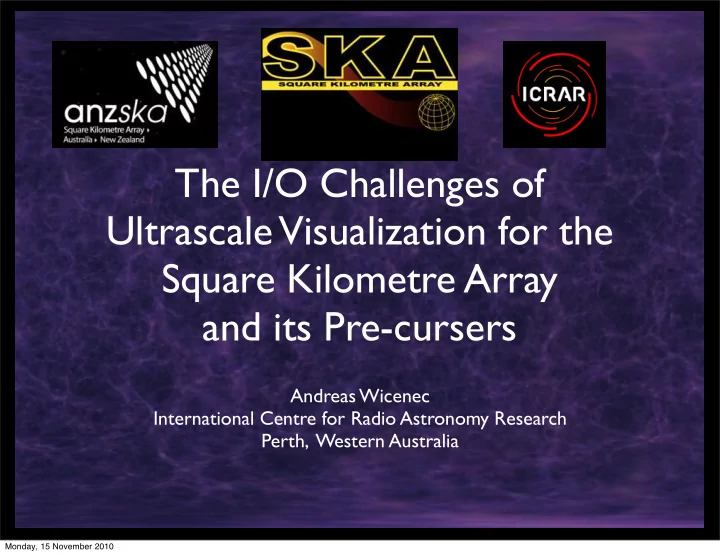

The I/O Challenges of Ultrascale Visualization for the Square Kilometre Array and its Pre-cursers Andreas Wicenec International Centre for Radio Astronomy Research Perth, Western Australia Monday, 15 November 2010
Intro “The output from leading-edge scientific simulations is so voluminous and complex that advanced visualization techniques are necessary to interpret the calculated results.” This talk is about a few upcoming and planned astronomical instruments producing multi-dimensional data sets at stunning rates and volumes using HPC as an integrated part of the data flow. Monday, 15 November 2010
Eyes on the Sky 100000000 10000000 1000000 100000 10000 1000 100 "Eye Balls" 10 1 Year 1500 1600 1700 1800 1900 2000 2100 Monday, 15 November 2010
Eyes on the Sky 100000000 10000000 1000000 100000 10000 1000 100 "Eye Doubling time ~ 20 years Balls" 10 1 Year 1500 1600 1700 1800 1900 2000 2100 Monday, 15 November 2010
Gathering numbers Monday, 15 November 2010
Gathering numbers 1610 Nearby stars Monday, 15 November 2010
Gathering numbers 1610 Nearby stars 1845 Ink sketch of nearby galaxy Monday, 15 November 2010
Gathering numbers 1610 Nearby stars 1845 Ink sketch of nearby 1880 galaxy First photographs Monday, 15 November 2010
Numbers per night 1E+12 ! 1E+11 ! 1E+10 ! 1E+09 ! 100000000 ! 10000000 ! Numbers/ ! 1000000 ! night ! 100000 ! 10000 ! 1000 ! 100 ! 1500 1600 1700 1800 1900 2000 Year ! Monday, 15 November 2010
Numbers per night 1E+12 ! 1E+11 ! 1E+10 ! 1E+09 ! 100000000 ! 10000000 ! Numbers/ ! 1000000 ! night ! 100000 ! 10000 ! 1000 ! 100 ! 1500 1600 1700 1800 1900 2000 Doubling time < 1 year Year ! Monday, 15 November 2010
The deluge continues T 2 = 6 mth T 2 =12 mth Monday, 15 November 2010
The deluge continues T 2 = 6 mth T 2 =12 mth 1 GB/s Monday, 15 November 2010
The deluge continues T 2 = 6 mth T 2 =12 mth 1 GB/s 1 TB/s Monday, 15 November 2010
The deluge continues 1 Exabyte/yr T 2 = 6 mth T 2 =12 mth 1 GB/s 1 TB/s Monday, 15 November 2010
The SKA The Square Kilometre Array (SKA) will be the largest international astronomical facility of the 21 st century. It will consist of up to 3000 dishes and hundreds of aperture arrays distributed over a range of up to 5000 km. The total collecting area will be of the order of one square kilometre. It will observe the sky in radio frequencies between 50 MHz and 35 GHz. The main science goals are in the area of the very early universe. In 2009 the world produced 1,000,000,000,000,000,000 bytes of information. The SKA could potentially produce this data volume in one day. Monday, 15 November 2010
ASKAP & MeerKAT The Australian SKA Pathfinder (ASKAP) and the South African MeerKAT are currently under construction and represent 1% SKA each. Technology testbeds and scientific facilities. Will produce science data cubes of about 6 TB each. ASKAP is a wide field survey instrument and will produce several thousand cubes per survey. 10 surveys have been proposed. Monday, 15 November 2010
Crunching the numbers credit: T. Cornwell Monday, 15 November 2010
Reading numbers • Data comes in cubes • SKA Pathfinder Cubes ~ 6 TB which implies 600 sec read time at 10GB/sec • typical survey consists of ~1500 cubes = 10 days read time • would like 100-1000 GB/sec for on-demand processing single cubes and cube groups. Monday, 15 November 2010
New Type of SC • I/O is THE bottleneck for this kind of science • Joining of HPC, highest performance storage and database technology == Data Machine • Dedicated HPC design for Data Intensive Research (DIR) and visualisation • Integration and optimisation of job scheduling and data movement from lower to highest tiers required. • Integration of data movement from high performance storage to host and device memory. Monday, 15 November 2010
Simulation credit: D. Beard, A. Duffy, R. Crain DIRP = Data Intensive Research Pathfinder and the GIMIC team Monday, 15 November 2010
DIR Machine DesignV0.5 • 100 nodes • 20 TB+ direct attached storage/ node NVIDIA Corporation • 9 TB host memory, 0.6 TB device memory • 200 GPUs, 1200 CPU cores • 100 PCI I/O cards or some PCI I/O SANs • Infiniband interconnect • Very similar to Johns Hopkins’ Data-Scope Monday, 15 November 2010
DIR Machine Benefits • 200-500 GB/s aggregate I/O bandwidth between disks and GPUs • ~ 1,000,000 IOPS on I/O cards/SAN • > 200 TFLOP/s • 40 Gbps interconnect • > 2PB direct attached storage • Scales very well to bigger installations Monday, 15 November 2010
DIR Environment Simulation credit: Daniel Beard, Alan Duffy, Paul Bourke and the OWLS team Monday, 15 November 2010
Algorithmic Challenge Monday, 15 November 2010
Algorithmic Challenge Monday, 15 November 2010
Algorithmic Challenge Monday, 15 November 2010
Algorithmic Challenge Monday, 15 November 2010
Simulation credit: Daniel Beard, Alan Duffy, Paul Bourke and the OWLS team Monday, 15 November 2010
Thank you! and Yes, we ARE Hiring! http://www.icrar.org/employment#hpc Thanks to Kwan-Liu for the invitation Thanks to A. Duffy, S. Westerlund, P . Quinn, K. Vinsen, C. Harris and D. Gerstmann for their input. Monday, 15 November 2010
Recommend
More recommend